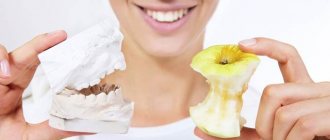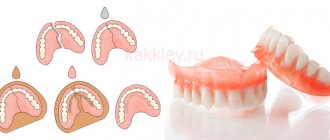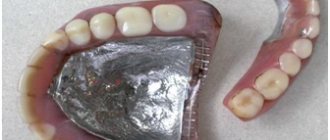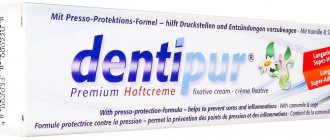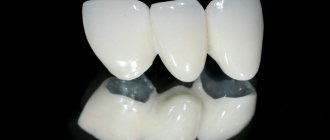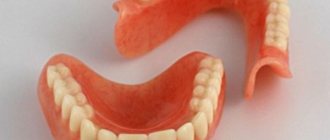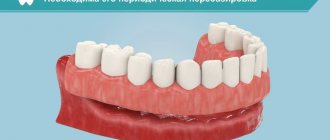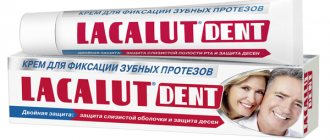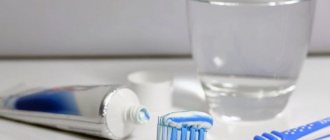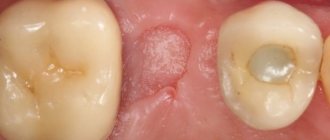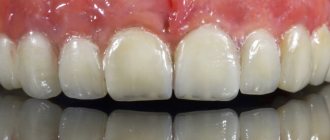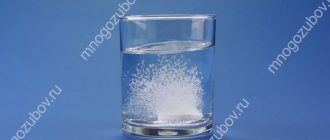2109
Today, dentistry uses a large number of materials that were previously available only to other areas of medicine.
The available range allows us to produce designs for various purposes, costs, and also suitable for people with different body characteristics.
Types and purpose of structures
A denture is an orthopedic product that replaces lost teeth. The design restores the anatomy of the dentofacial apparatus, its functionality, and returns the patient the opportunity to smile without embarrassment.
When manufactured correctly, the structure does not cause inconvenience or discomfort; from the first days a person perceives it as his own teeth.
The choice of design depends on the following features:
- number of missing or deformed elements;
- state of the prosthetic bed;
- gum condition.
All existing prostheses are divided into two types:
- Fixed . These are structures installed in the oral cavity for a long period (usually several years) in the absence of several teeth or restoration of their damaged tissues. A person does not need to remove them for hygienic treatment.
- Removable . They are used for partial or complete edentia, in the presence of a significant defect in the dentition. You can remove it yourself at any convenient time, and also put it on without damaging the tissues.
Fixed dentures come in several varieties:
- Single crown – placed on a tooth that has a minor defect (the crown part is not completely destroyed, the root is preserved).
- Bridge – used in case of damage (absence) of several adjacent units.
- An implant is a system that imitates a tooth along with its root, i.e. when an artificial crown is mounted on an implant implanted in the gum.
- Veneers are overlays placed on the outside of teeth for minor defects - chips, cracks, etc.
Removable structures can be:
- Full . They are installed in the edentulous oral cavity, resting on the palate and gums.
- Partial . They are selected if there is one or several intact dental elements in the mouth, which will act as a support for fastening.
There is no universal method for eliminating adentia that would suit all patients. The selection of a method for restoring the integrity of the dentition and their functionality for this problem is always individual.
What are telescopic dentures and the prerequisites for their installation.
Come here if you are interested in the features of Vertex prostheses.
At this address https://www.vash-dentist.ru/protezirovanie/semnyie-p/neylonovyie/tehnologiya-dental-di-dlya.html detailed information about Dental Di removable dentures.
Types of fixed dentures
Permanent structures are used for caries and enamel damage. This type of prosthetics helps give teeth an aesthetic shape and color. Durable materials are used for products - ceramics, metal.
Fixed dentures are installed permanently or for a certain period. The appearance of modern models does not differ from natural crowns.
In what cases are permanent structures indicated:
- To replace lost teeth if 1-2 crowns are missing.
- Advanced caries.
- To eliminate crown defects: cracks, chips.
- Increased abrasion and sensitivity of enamel.
- Giving the desired shape and color.
Depending on the disorder, the specialist installs a suitable prosthesis model:
- Crowns . This type of structure is used to cover living teeth or implants. They are made of metal. Crowns were popular in the past. Nowadays, they are installed mainly on chewing teeth. Or they use metal-ceramics for an aesthetic appearance if the crowns are attached to the front teeth. Ceramic models come in a variety of shades. This allows you to choose the right product for a natural smile. The disadvantage of metal-ceramic models is that for grinding it is necessary to remove a large layer of living tooth. Ceramic products are fragile and expensive.
- Bridges . The design consists of several crowns. The advantage of bridges is reliability and quick adaptation to the prosthesis. They are installed if there are supporting teeth on the sides of the row. The bridge is attached to them. The prosthesis can be installed supported by implants.
- Veneers (microprostheses) are plates that are mounted to the teeth with special glue. They are used to eliminate visible defects: yellowness, darkening of enamel, bite correction, chips. The plates reduce the sensitivity of the crown. Microprostheses are made of ceramic, composite or a more durable material – zirconium dioxide. The models are safe because... made from biocompatible compounds.
- Tabs. With the help of prosthetics, violations are corrected: fillings, caries, abrasion. Inlays, unlike fillings, are durable and cover large cavities.
- Dentures on implants are an imitation of a living root. First, a pin is inserted into the gum - an artificial root. A crown is mounted on it. After installation, the pin fuses with the bone. While the natural union is taking place, the patient is given a temporary prosthesis. Fusion occurs within 3-6 months. Then the permanent crown is attached to a special compound. A prosthesis on implants is reliable and durable. The disadvantages are the lengthy installation and fusion of the living root with the pin, and the high price.
Dentures are not always comfortable to use.
Denture adhesive will securely hold the denture in place, making it more enjoyable to wear. We will tell you about the features of upper jaw prosthetics with a clasp denture here.
Is it necessary to depulp a tooth before prosthetics? You will find the answer to this question in the article.
Read also: For fixing dentures
Raw materials for permanent products
Fixed structures greatly simplify the life of their owners , since artificial elements do not require special care. There is also no chance of it falling out of your mouth at the most inopportune moment.
All models of dentures are united by fairly high aesthetics (indistinguishable from natural teeth), wearing comfort, quick adaptation and long-term (and for some, lifelong) operation. But, at the same time, they are much more expensive than removable models, and have more restrictions on installation.
For production usually used:
- ceramics;
- composite;
- metal ceramics;
- plastic.
Ceramics
The main advantage of this material is its high aesthetic performance due to its closeness in color to enamel.
Artificial crowns made of ceramics are no different in appearance from anatomical organs, i.e. the shade, shape and level of transparency correspond to your own teeth.
Modern technologies have been able to increase the strength of the material, which allows such crowns to restore chewing units. Another advantage of ceramics is lightness. Teeth made of this material are practically not felt in the mouth.
It is necessary to give preference to the material to the group of patients who have a tendency to allergies. Ceramics are absolutely safe for allergy sufferers and very rarely lead to redness, swelling, bleeding, or inflammation.
But many people are stopped by the high cost and fragility of products (when compared with other materials). During operation, they require special care and compliance with certain safety measures.
Metal ceramics
Metal-ceramic dentures are a frame made of a precious, semi-precious, non-precious metal alloy, onto which dental ceramics are then poured or sprayed. Due to the fact that the frame can be made from different alloys, metal-ceramic orthopedic products will differ from each other in their main characteristics: strength, cost, individual tolerance, aesthetics.
- Frame made of non-precious alloys. Such prostheses are the most popular, relatively inexpensive, and have a service life of up to 12 years.
But they can fail prematurely due to oxidation by saliva, and there is a possibility of darkening of the gum tissue near the crown. They are made on the basis of cobalt, chromium and nickel.The chromium-nickel base is the most affordable, but it is not strong enough, quickly deforms, and allergies to nickel are common.
The cobalt-chromium frame has increased hardness and is less deformed, which reduces the likelihood of ceramic chipping. Reactions to metals are rare.
- The titanium base is lightweight , corrosion resistant, biocompatible with tissues and lacks intolerance. But special ceramics with a low expansion coefficient are used to coat it.
- Frame made of precious material. It uses gold, which has anti-corrosion resistance, no allergies, sufficient strength, and ductility.
When making such a base, the accuracy of the prosthesis itself is achieved, its perfect fit to the supporting element is ensured, the likelihood of developing caries in adjacent units and the possibility of decementing or breaking the product are reduced.The service life of gold-based metal ceramics increases to 15 years. But its only disadvantage is its high cost.
- Frame made of semi-precious alloy .
Alloys with a high percentage of gold are taken - up to 85%, platinum - about 9%, 4-5% - palladium. The material turns out light yellow, is not oxidized by saliva, and does not cause an allergic reaction. A crown with such a base has high aesthetic values, a long service life (up to 15 years) and an accurate fit.
In the video, a specialist will tell you which is better - ceramics or cermets.
Composites
The most popular material in prosthetics. A composite is a polymer compound consisting of additional components, the main ones of which are silicon oxide, glass, quartz, and porcelain flour.
All these components make it possible to produce a prosthesis that is close in all respects to real teeth, durable, and has a long service life - more than 15 years.
Modern composites have only one drawback - high cost. But if you want to install a prosthesis just once and for almost your entire life, this is the ideal material.
Plastic
In prosthetics, plastic is a popular material due to its affordability. But its main characteristics are significantly inferior to all the materials mentioned above.
Plastic structures are short-lived - they are easily destroyed and deformed. They are difficult to make comfortable and aesthetically pleasing.
Dentures also absorb various foreign odors well and are colored with dyes found in juices, berries, tea, some vegetables, coffee, etc.
Plastic is a porous material, therefore it is favorable for the proliferation of pathogenic microorganisms that inhabit the oral cavity.
The only solution to avoid the manifestation of serious pathologies in the mouth is thorough daily hygienic cleaning of the teeth and the prosthesis itself.
Pros and cons of Valplast prostheses, indications and contraindications for installation.
In this article we will talk about the features of Flexite prostheses.
Here https://www.vash-dentist.ru/protezirovanie/semnyie-p/s-pomoshhyu-armirovaniya.html we will talk about methods of denture reinforcement.
Metal alloys in prosthetics
Another commonly used material used to make artificial teeth is special metal alloys. It is usually a compound of chromium and cobalt or chromium and nickel. The biggest advantage of such connections is their increased strength and resistance to mechanical damage.
But a significant drawback of such designs is their increased allergenicity: they often cause adverse reactions in patients prone to unpleasant body reactions. If a patient requires jaw restoration and prefers metal alloys, it is recommended that he use an alloy made of precious and precious metals. Thus, an alloy of gold with platinum and palladium is a rather expensive material, but in terms of strength and safety, such a prosthesis will not be equal.
If financial status allows, it is better to make a prosthesis made of such an alloy extended, so the patient can enjoy the convenience and feeling of naturalness, and the possibilities of modern medicine will make the design aesthetically correct. Such a prosthesis will fully match the appearance of natural teeth thanks to a special ceramic coating.
The next metal used in prosthetics is titanium. Titanium structures are the most modern material in prosthetics today. Prostheses and dentures are distinguished by the following qualities:
- strength;
- ease;
- increased security.
The only thing that specialists are unable to provide to titanium structures is full compliance with aesthetic characteristics. Therefore, titanium crowns are most often used to restore distant molars - in these parts of the oral cavity they are less noticeable to others, while still performing their task 100 percent.
One of the “oldest” materials used in prosthetics is zirconium oxide. This material is also strong and stable, and has high biological properties: this alloy is practically safe for the tissues of the human body. Thanks to its color - white with a silver tint - zirconium oxide has high aesthetic characteristics and blends perfectly with the natural color of the enamel. This alloy is processed with a laser, which allows you to give the prosthesis a shape that fully matches the shape of the lost tooth.
For removable systems
Today, for that category of patients who have no teeth in their mouths, orthopedists offer removable structures that create the effect of integrity of the dentition. Usually these are elderly people who lose teeth due to age-related changes progressing in the mouth.
All removable dentures are characterized by quick production, affordable cost, good aesthetic characteristics, and some do not even need to be removed at night.
But not all options are able to stop bone tissue atrophy (its progressive decrease).
Acrylic or nylon are usually used to make such structures.
Acrylic
Acrylic mass is a classic material used in prosthetics for quite a long time. But unlike the “old” sample, in modern acrylic the volume of monomer remaining after polymerization is reduced to a minimum , which reduces the likelihood of allergies and toxic stomatitis.
In addition, additives are now added to the material, which, upon completion of cooking of the product, create a specific pattern on its surface that replicates the oral mucosa.
The advantages of the material include its other characteristics:
- easy;
- affordable;
- practical;
- holds its shape well;
- aesthetic;
- wear-resistant;
- little susceptible to mechanical stress.
Acrylic also has some disadvantages:
- when wearing an acrylic prosthesis for a long time, allergies develop;
- the hardness of the material contributes to tissue rubbing and injury;
- plaque quickly accumulates on the surface, which is explained by the porous structure;
- It may break or crack when biting or chewing hard foods.
Nylon
This is a relatively new and high-quality material that has proven itself on the positive side during its existence.
Nylon has the following positive characteristics:
- hypoallergenic, i.e. the material is non-toxic, does not provoke any reactions and is completely safe;
- impeccable aesthetic indicators;
- durable and reliable, despite its flexibility and softness.
Despite all the beauty of a nylon product and its convenience, the material has a number of disadvantages:
- The delicate texture is subject to pigmentation and is easily scratched.
- Nylon requires special care, i.e. It cannot be cleaned with the usual brush and paste.
- Once scratched, the material easily absorbs odor.
- Over time it sags.
- Flexibility and plasticity lead to bone tissue atrophy.
- High price.
There are quite a lot of varieties of materials for dental prosthetic structures in the arsenal of dentistry. They differ from each other in type, structure, cost and other parameters.
But regardless of what orthopedic products are made of, certain requirements are imposed on all materials:
- hypoallergenic;
- sufficient strength;
- aesthetics;
- compatibility with the mucous membranes and tissues of the mouth;
- hygiene;
- manufacturability;
- resistance to corrosion;
- lack of taste and smell.
In the video, a specialist will tell you which is better - nylon or acrylic for dentures.
Plastic and prostheses made from it
Plastic is considered a popular material in prosthetics. And although plastic products are the most affordable financially, their characteristics are inferior to all other materials. Plastic structures are easily destroyed, they are difficult to make aesthetically correct and comfortable enough. Also, such dentures tend to absorb foreign odors and colors from natural and artificial dyes - coffee, tea, berries, beets, etc. Therefore, these structures do not have durability and can become deformed and break.
Plastic is also a porous material, and this becomes a favorable environment for the proliferation of various microorganisms that inhabit the oral cavity. The only way to avoid the occurrence of severe oral diseases is thorough hygienic treatment of both the denture and the teeth and gums themselves. Therefore, plastic dentures are usually removable - this allows them to be removed, washed in running water, thoroughly cleaned and disinfected in special solutions.
But progress has also affected plastic prostheses: new designs are made of nylon, which increases the strength of the structure and makes it safer for the patient. Nylon structures are less susceptible to mechanical deformation and damage, do not cause allergic reactions and do not allow pathogenic microorganisms to linger on them. Such properties allow the use of nylon in children's prosthetics, when long-term construction is not required, and bioparameters are extremely important.
Nylon dentures blend almost perfectly with the tone of natural teeth and gums, and they are secured using invisible clasps. All this makes nylon very popular in prosthetics.
Price
The price of a denture consists of several components, but is primarily determined by the material from which it was made.
The cost of different types of orthopedic structures is presented in this table:
| product name | Material | Cost in thousand rubles |
| Single crown | Metal ceramics | from 6 |
| Ceramics | 13-16 | |
| Composite | from 8 | |
| Plastics | from 5 | |
| Bridge prosthesis | On a frame made of precious metals | from 19 |
| On a frame made of non-precious materials | from 10 | |
| Base made of semi-precious materials | from 14 | |
| Veneers | Ceramics | from 13 |
| Composite | from 5 | |
| Complete removable denture | Acrylic | from 12 |
| Nylon | from 32 | |
| Partial removable denture | Acrylic | from 8 |
| Nylon | from 26 | |
| Micro prosthesis “butterfly” | Acrylic | from 5 |
| Nylon | from 14 |
All prices shown are approximate. The exact numbers should be found in the price list of the clinic where the prosthetics will be performed.
Which prosthetic material is better?
It is impossible to answer this question immediately. Each person has their own characteristics in the structure of their teeth. Someone lost only a few teeth. It is better for such people to use implants. Others have only a few healthy teeth. In this case, it is better to use one of the removable dentures. And someone was left completely without teeth. For them – fixed dentures.
The choice of material is primarily influenced by price. The comfort and service life of the prosthesis will depend on this choice. For example, the clasp design is not noticeable in the oral cavity compared to plate dentures. But they are much cheaper in price. And purchasing clasp or acrylic dentures is quite expensive.
Only a specialist can understand the variety of modern materials and advise which type of material is right for you.
Reviews
Until recently, creating and placing a prosthesis was difficult. Modern materials have helped facilitate this process, make wearing dentures more comfortable, and also made it possible to create an ideal replacement for lost teeth - highly aesthetic, durable and comfortable.
You can talk about your experience of wearing dentures, the pros and cons of the material from which they are made, by leaving a comment on this article.
If you find an error, please select a piece of text and press Ctrl+Enter.
Tags fixed dentures removable dentures
Did you like the article? stay tuned
Previous article
Professional teeth cleaning Clinpro – gentle and effective care
Next article
What properties of laser are valuable for the treatment of caries?
